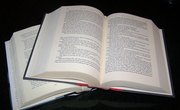An asterisk is a small, star-shaped symbol (*) used in specific grammatical situations. Asterisk grammar usage has several purposes in written communication or formal writing. In some cases, the asterisk can be used in logos, brand names or to highlight or draw attention to certain words. In this case, the use is casual and informal.
The asterisk has several specific uses including as a way to denote that something is omitted and to indicate an annotated footnote. Typically, a reader knows to look for the note associated with the asterisk and understands the asterisk grammar definition. Footnotes are located at the end of the text, so a reader will look to the end to find the corresponding asterisk to read the additional information.
Historically, the asterisk is one of the oldest textual marks dating back over 5,000 years. Some linguistic historians believe it is the oldest editorial mark. The word asterisk is Greek, derived from the word asteriskos, which means ‘little star.’ The asterisk is a versatile editorial mark. However, it’s important to understand its proper usage and the guidelines for it.
Asterisk Use
The most common use for an asterisk is to denote a footnote. In other words, if more information is included about a written statement, the asterisk would direct the reader to the information below. The additional information usually follows the original section of text; often located at the bottom of the page.
The asterisk can also be used to clarify a disclaimer. The additional information that follows the asterisk can also clarify or give specify parameters. Again, the asterisk symbol serves to direct the reader to the additional information.
Additionally, the asterisk can be used to omit certain letters in some words. One specific example includes when a direct quote is used. For reported stories, often times writers use direct quotes from people who have first-hand experience. In the event a witness uses unfavorable language, the asterisk would be used to omit certain letters.
Asterisk Examples
- When the asterisk is used to direct the reader to a footnote or annotation, it looks like this:
The category 3 storm devastated the area and killed 4,000* people.
*Data reported from U.S. Coast Guard.
- When the asterisk is used as a disclaimer, it looks like this:
Sale! Everything must go! 100 percent financing or 90 days same as cash*!
*Credit approval with minimum score required.
- When the asterisk is used to omit certain letters in a word, it looks like this:
The bystander reported the terrifying event, “It was terrifying! The sound was so loud it scared the sh*t out of me!”
Where Is the Asterisk?
The asterisk, a small round star-shaped symbol is located on the computer keyboard. It is located on the number eight key. However, in order to insert the asterisk, you must first press the ‘shift’ key, then the number eight key. The shift key plus the eight key will insert the asterisk into your writing.
Whether the use is formal, or casual, the asterisk serves many purposes. When used appropriately, it guides the reader to additional, usually important information. The asterisk can provide disclaimers or fine print for sales, contests or giveaways.
The asterisk can also clean up language when needed. Using first-person quotes can have a profound impact on an article; however, not everyone uses proper English in every situation. This way, you can get the correct message across without offending readers.
Whatever ways you may use the asterisk, it is important to fully understand and follow the appropriate usage guidelines. It’s a good idea to use the asterisk in small, effective doses and steer away from over using it.
Related Articles
Resources
Tips
- The asterisk symbol is found above the number 8 key on your keyboard.
Writer Bio
Melanie Forstall has a doctorate in education and has worked in the field of education for over 20 years. She has been a teacher, grant writer, program director, and higher education instructor. She is a freelance writer specializing in education, and education related content. She writes for We Are Teachers, School Leaders Now, Classroom, Pocket Sense, local parenting magazines, and other professional academic outlets. Additionally, she has co-authored book chapters specializing in providing services for students with disabilities.










